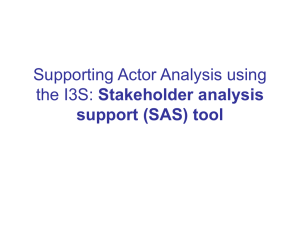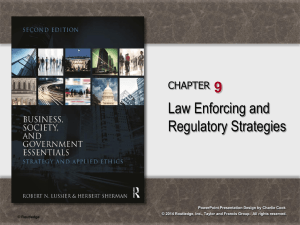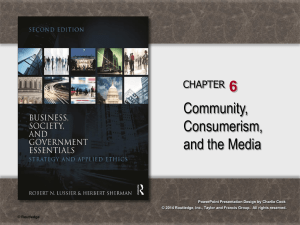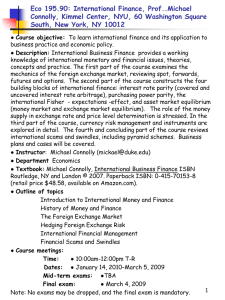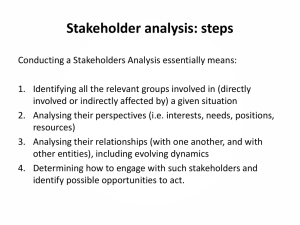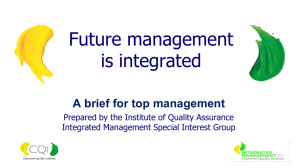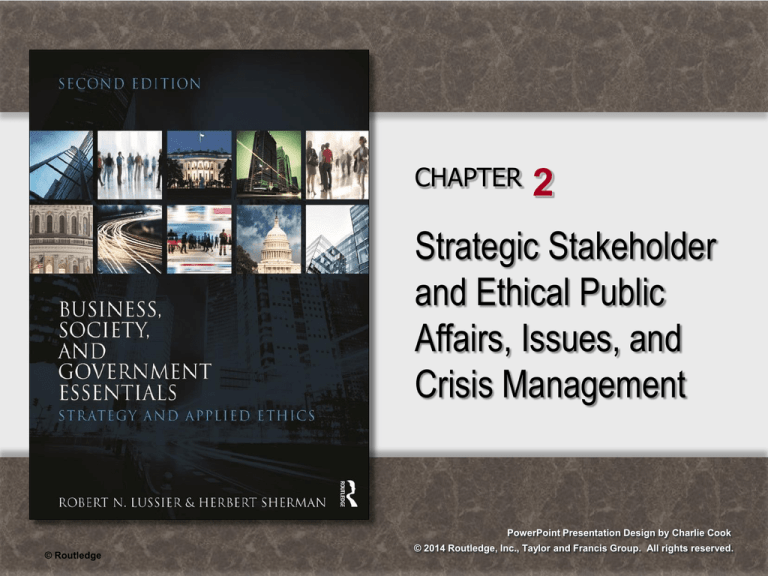
CHAPTER
2
Strategic Stakeholder
and Ethical Public
Affairs, Issues, and
Crisis Management
PowerPoint Presentation Design by Charlie Cook
© Routledge
© 2014 Routledge, Inc., Taylor and Francis Group. All rights reserved.
Learning Outcomes
After studying this chapter, you should be able to:
1. Describe stakeholder management and the need to balance
stockholder and other stakeholder interests
2. Differentiate public affairs management from issues management
3. Identify the three-phase process of issues management
4. Define crisis and discuss the four stages of crisis management,
including the 3 As of crisis communication
5. List and briefly describe the 5 Is strategic analysis
6. Categorize the issue life cycle stages with the strategic focus for each
stage
7. Define the key terms in this chapter
© Routledge
Balancing Owner and Strategic
Stakeholder Interests
Stockholder
Approach
Management, as the agent of owners/stockholders,
has traditionally focused on meeting the needs of the
owners/stockholders and maximizing profits without
regard for any of the other business stakeholders.
Stakeholder
Approach
Management seek to make ethical decisions on
specific issues that address both owner needs for the
creation of value and the needs of strategic
stakeholders who can affect and are critically
affected by the firm’s actions and performance.
© Routledge
Public Affairs and Issues Management
Public Affairs
Activities and
Functions
Refers to how business interacts with and
maintains its relationships with
stakeholders.
Public Affairs
Management
The process of developing corporate public
policies and strategies regarding how the
business will interact with stakeholders in
the business, social, and government
environments using issues management,
crisis management, and strategic analysis.
Issues
Management
Involves identifying, monitoring, analyzing,
and selecting public issues that warrant
nonmarket strategies.
© Routledge
Figure 2.1
© Routledge
Public Affairs Activities and Functions
Public Affairs and Issues Management
Issues
Management
Involves identifying, monitoring, analyzing,
and selecting public issues that warrant
nonmarket strategies.
Issues Management Precludes Crisis Management
The better managers deal with an issue, the less
likely the issue is to escalate into a crisis.
Scanning the
environment
for issues
© Routledge
Evaluating
issue impact
on the firm
Conducting
a strategic
analysis
Figure 2.2
The Issues Management Process
Scanning the environment
to identify issues and trends
that will affect the business
Evaluating the impact
issues will have on the
firm and ranking issues
by priority
© Routledge
Conducting a strategic
analysis to develop
strategies for dealing with
high-priority public affairs
issues
Crisis Management
Crisis
A major unexpected event that has a large
negative consequence on a firm.
Crisis
Mentality
The belief that a crisis (e.g., violence, accident,
or natural disaster) is unlikely to happen to our
business.
Crisis Management Stages
1. Developing the crisis team
2. Planning—risk assessment, monitoring,
and crisis prevention
3. Managing the crisis—communication
4. Analyzing post crisis
© Routledge
Crisis Management Team Activities
1. Conduct risk assessment and ranking to identify
potential crisis events and determine the necessary
degree of preparedness.
2. Utilize constant risk monitoring to anticipate crisis events
and initiate a preplanned action when necessary.
3. Develop risk prevention and damage reduction
strategies that can prevent a crisis, identify the warning
signs of a crisis, and reduce damage if crisis occurs.
4. Have updated plans in place to respond quickly to a
diversity of possible crises.
© Routledge
Managing the Crisis—Communication
1. Timely communication is required as the firm may have
only minutes to contain a crisis.
2. The crisis spokesperson (leader) should follow the
“three A’s” of crisis communication:
• Acknowledge the crisis.
• State the Action to be taken to deal with the crisis.
• State how the crisis will be Avoided in the future.
3. Top management launches a post-crisis evaluation
(preferably conducted by an objective third party) of the
organization’s effectiveness in managing the crisis.
© Routledge
Strategic Analysis Stages: The Five Is
Issue
Identification
Interaction
strategies
Information
about issues
© Routledge
Interested
strategic
stakeholders
Incentive of
stakeholders
The Nonmarket Issues Life Cycle
Formation of issue and public sentiment
Interested stakeholder formation
Issue brought for voluntary action
Legislative and regulation formation
Enforcement and litigation
© Routledge
Figure 2.4
The Issues Life Cycle and Strategy Focus
Stage 1
Stage 2
Stage 3
Stage 4
Stage 5
ISSUE
Identification and
Interested
formation of the
stakeholder
issue and public
formation
sentiment (possibly
news media
coverage)
Issue brought Legislative and
to business for regulation
voluntary action formation
(may be
skipped)
Enforcement
and litigation
Varies based
Political lobbying
on the issue
to prevent or
and who brings support change
it
Legal—comply
with changes and
avoid or bring
lawsuits→
STRATEGY
Informational and
societal strategies
to influence the
development of
the issue
© Routledge
Informational
and societal
strategies,
developing
coalitions
The 5 Is Strategic Analysis Steps
1
2
Issue
identification
Interested strategic
stakeholders
Business
Strategy
implementation
and evaluation
5
Interaction
strategies
© Routledge
• Owners/
Shareholders
• Employees/
Managers
3
Incentive of
stakeholders
4
Information—Objectives
Strategic Analysis of Nonmarket Issues
1. Issue Identification Questions:
• What is the issue?
• At what stage in its life cycle is the issue?
2. Identification of Interested Strategic Stakeholders:
• Which stakeholders support or will benefit from
strategic action taken on the issue?
• Which stakeholders do not support or will not benefit
from strategic action taken on the issue?
© Routledge
Strategic Analysis of Nonmarket Issues (cont’d)
3. Incentives of Stakeholders:
• What is the basis for the legitimacy of stakeholder
claims on the firm?
• How much power do the stakeholders have to affect
the performance of the firm?
• How urgently does a nonmarket strategy need to be
developed and implemented?
• What is the likelihood of stakeholder action based on
its costs versus its benefits to stakeholders?
• Which actions could stakeholders take?
• What would be the consequences of those actions?
© Routledge
Strategic Analysis of Nonmarket Issues (cont’d)
4. Information
• What do people know or believe about the issue and
the forces affecting the issue’s development?
• Which objectives (end results) must the firm achieve
to create value for stakeholders?
• What information is needed to meet the objectives?
• How will the firm confirm the veracity and accuracy of
its information sources?
• How will the firm sort out truthful facts from
assumptions and sentiments?
© Routledge
Figure 2.5
Stakeholder
Stakeholder Incentives and Powers
Incentive—Measure of Costs vs.
Benefits
Power—Strategic Action
Stakeholder Might Take
Market Environment
Stockholders
Sales and profits
Fair return on investment—dividends
Increased value of stock
Managers/
Employees
Compensation (wages and benefits)
Job security and opportunities
Working conditions
Customers
Price
Quality
Safety
Buy from competitors
Boycott if products or policies don’t
meet expectations
Suppliers
Gain, or lose, sales to firm
Payment, in full and timely
Relationship, ethical
Provide needed products
Refuse to sell to firm
Slow down delivery
Sell to competitors
Competitors
May face same issue
Fair competitive practices
Complain to regulators
File lawsuits
© Routledge
Vote for board of directors
Pressure board and managers
Union/collective bargaining
Work slow down—call in sick
Strike
Figure 2.5
Stakeholder Incentives and Powers (cont’d)
Stakeholder
Incentive—Measure of Costs vs.
Benefits
Power—Strategic Action
Stakeholder Might Take
Nonmarket Society Environment
Societal
Interest
Group
Monitor firm to ensure compliance with
its interest
Business
Associations
Provide research and information
Business creation of value
Provide staff and resource help
Provide political and legal help
Community and
Consumerism
Not hurting environment
People are part of other stakeholder
group power
News Media
Inform community of issues
Shape public sentiment
Shape nonmarket agenda
© Routledge
Picketing
Organize demonstrations and rallies
Boycott
Appeal to press
Appeal to government
File law suits
Provide positive news coverage
Provide negative news coverage
Figure 2.5
Stakeholder
Stakeholder Incentives and Powers (cont’d)
Incentive—Measure of Costs vs.
Benefits
Power—Strategic Action
Stakeholder Might Take
Nonmarket Government Environment
Legislative
Make laws to help business and
society
Executive
Enforce laws
Make and enforce regulations to help
business and society
Tell firm what practices it can and can’t
perform and make firm comply
Can close down business
Judicial
Interpret the law
Determine litigation outcome
Can change laws
Decide who wins lawsuits
© Routledge
Make firm practices legal (can do) or
illegal (cannot do)
Writing Objectives
• Objectives state the end result the business
wants to achieve in trying to create value for the
stakeholders of the issue.
• The writing objectives model:
To + action verb + singular, specific, and measurable
result to be achieved + target date.
Increase current bottom-line profits by 25% no later
than the end of the first quarter of 2016.
© Routledge
Figure 2.6
Information
Source
Stakeholders
with subgroups
1. Business
2. Society
3. Government
© Routledge
Determining Whether Information Is Factual in Nature
Source
Interest
Reputation/
Expertise
1. Strategic
1. High
stakeholder
2. Medium
2. Stakeholder
3. Low
3. Disinterested party
Data
Confirmation
List other sources
with interest and
expertise ratings
Data/Fact
Determination
Guaranteed Fact
Nonmarket sources,
disinterested parties,
high reputation, multiple
sources
Probable Fact
Mixed sources,
stakeholder, medium,
reputation single or
double source
Questionable Fact
Market source, critical
stakeholder, low
reputation, no
confirmation
Sources of Information
Primary
Information
Data that is gathered directly by the
information seeker
Secondary
Information
Data that is provided by outside sources
Supportive
Information
Accurate facts and figures are made stronger
when gathered, or supported, by outside
sources
© Routledge
Information Strategies
Expert
testimony
Research by
outside
resources
Expertise of
supportive
stakeholders
Supportive
information
© Routledge
Strategic Analysis of Nonmarket Issues (cont’d)
5. Steps in the Creation of Interaction Strategies
• Brainstorm to generate creative alternative strategies
to meet the objective
• Forecast the market and nonmarket reactions and
consequences of each alternative
• Select most feasible and appropriate strategies
• Implement chosen strategies
• Evaluate and adjust strategies
© Routledge
Figure 2.7
© Routledge
The 5 Is Strategic Analysis Steps
Key Terms
3 As of crisis communication
issues to business
5 Is strategic analysis
public affairs (PA)
crisis
public affairs management
crisis management stages
stakeholder management
information strategies
strategic stakeholders
interaction strategies
issues life cycle
strategic stakeholders
with incentives
issues management
supportive information
issues management process
writing objectives model
© Routledge



